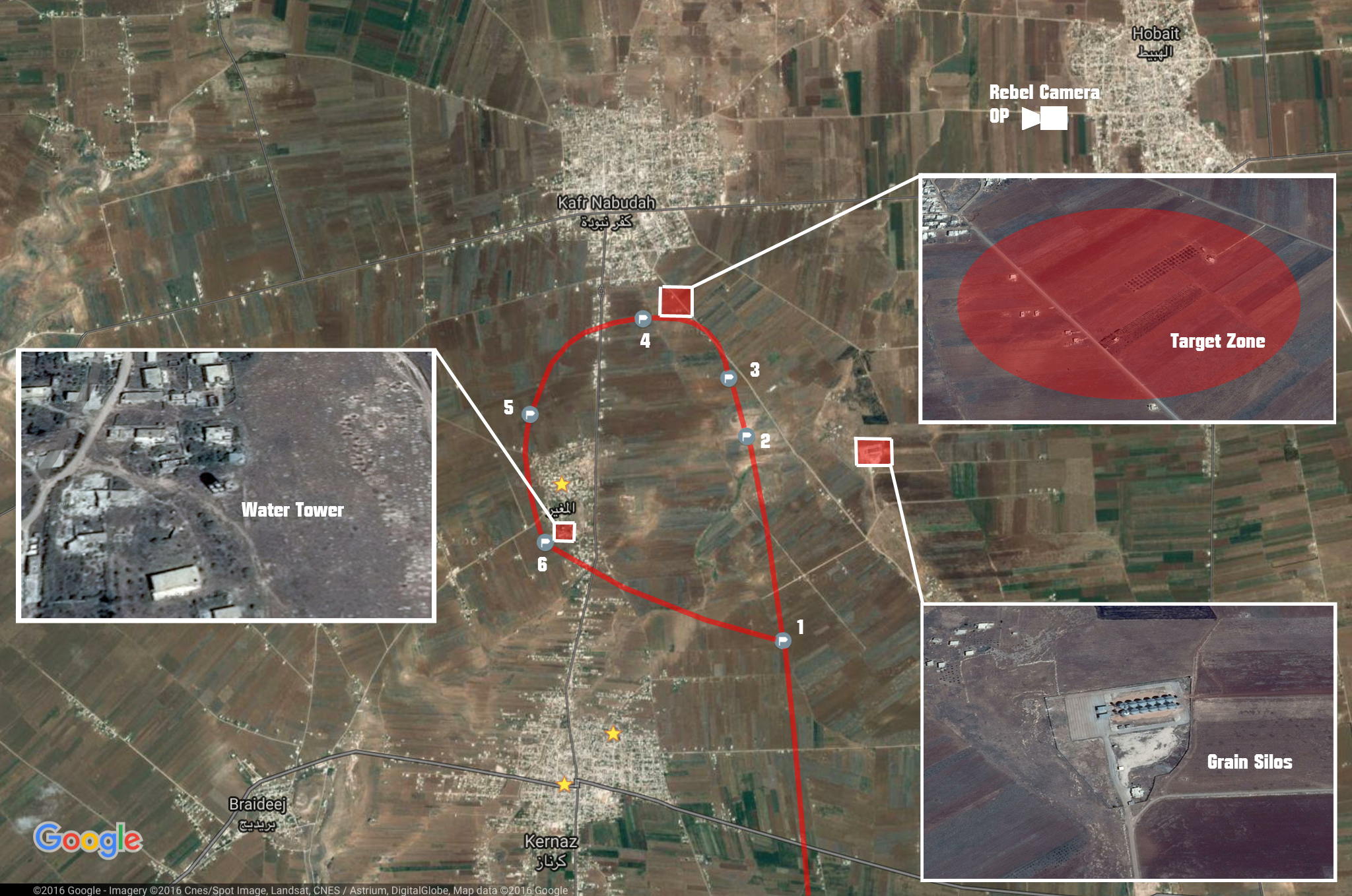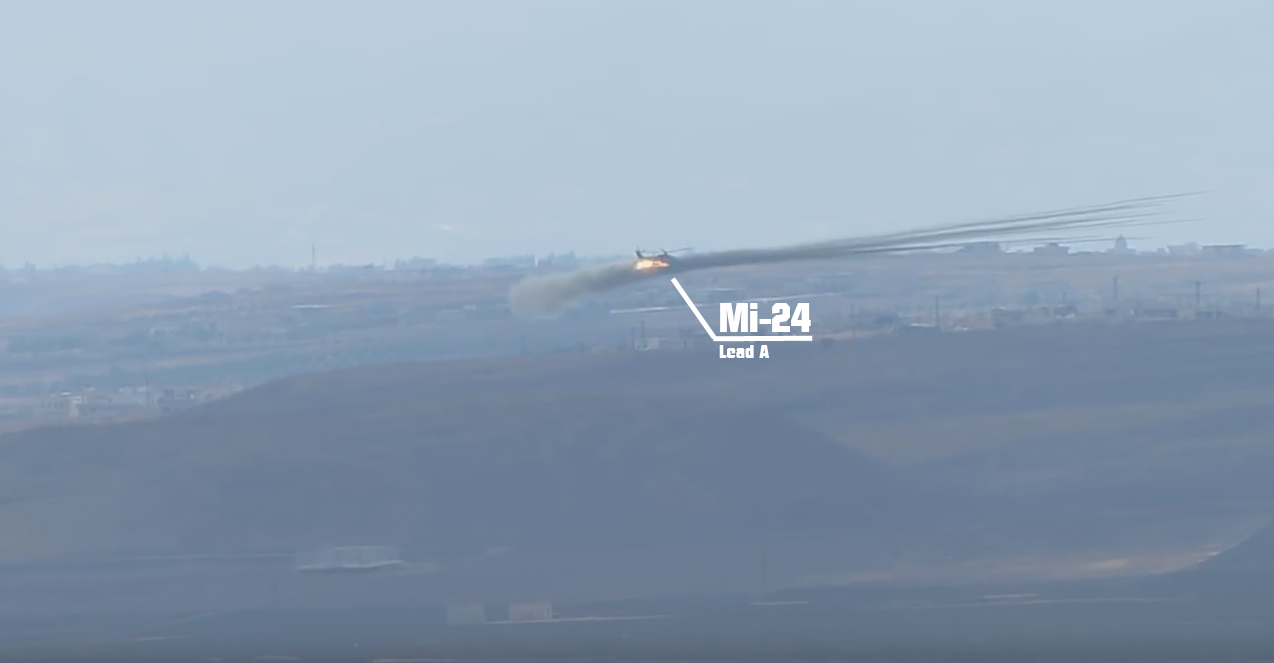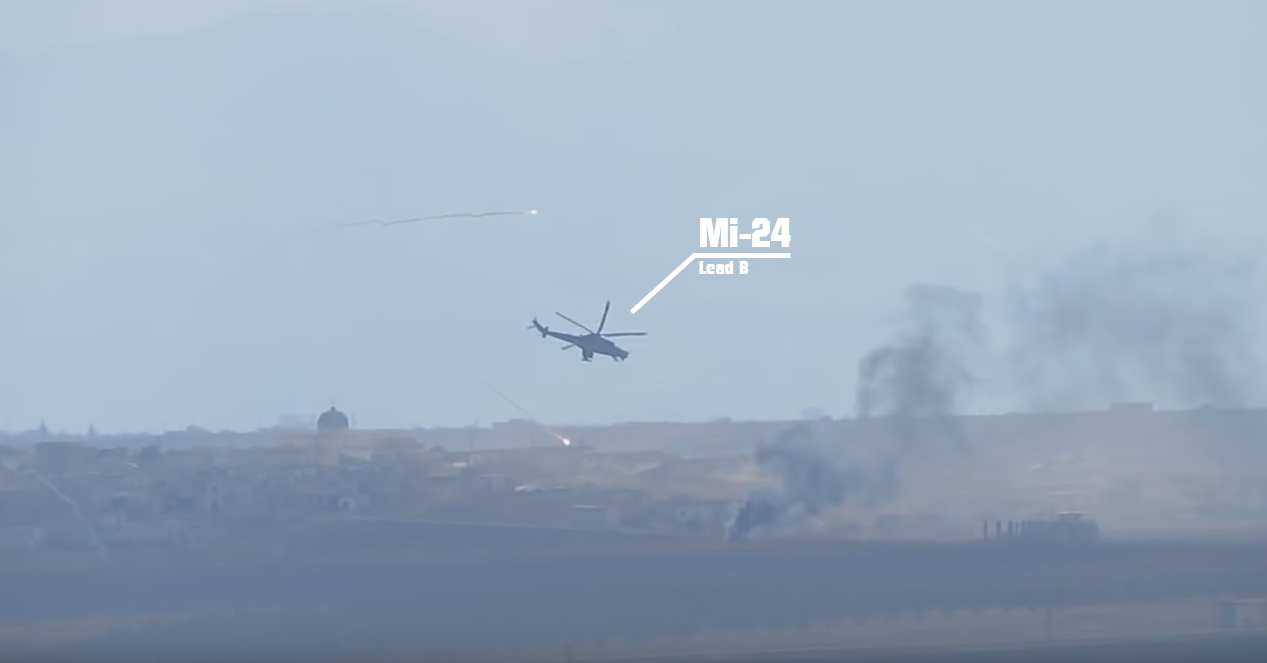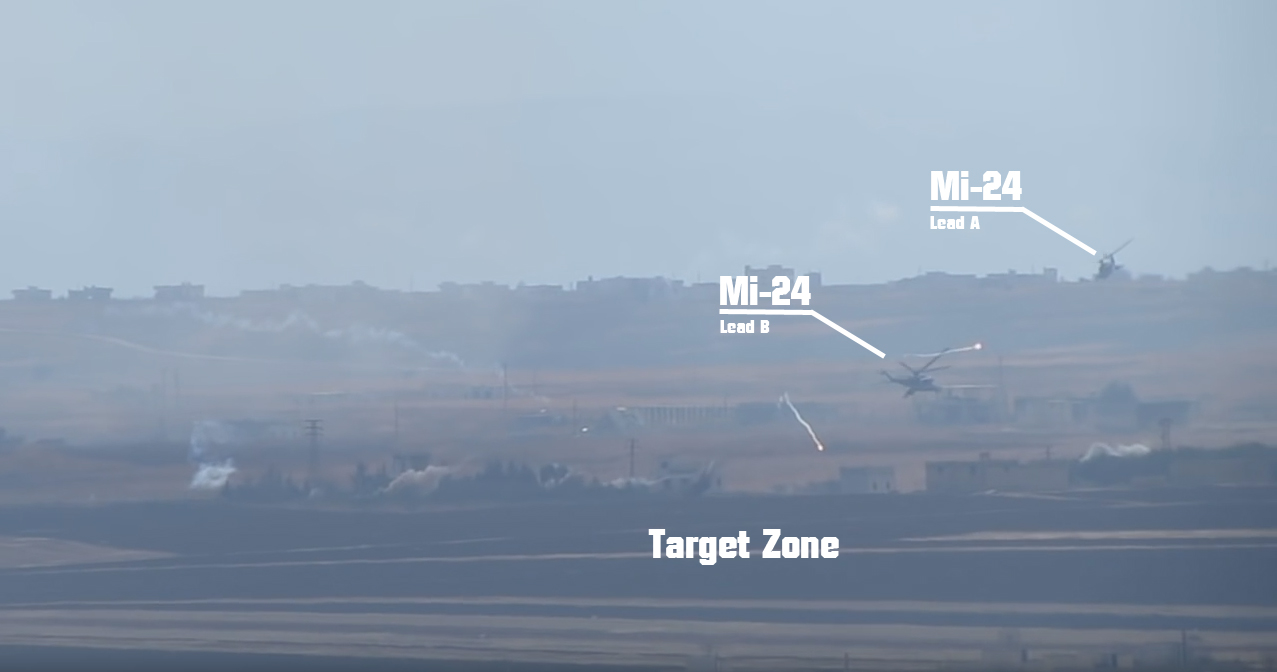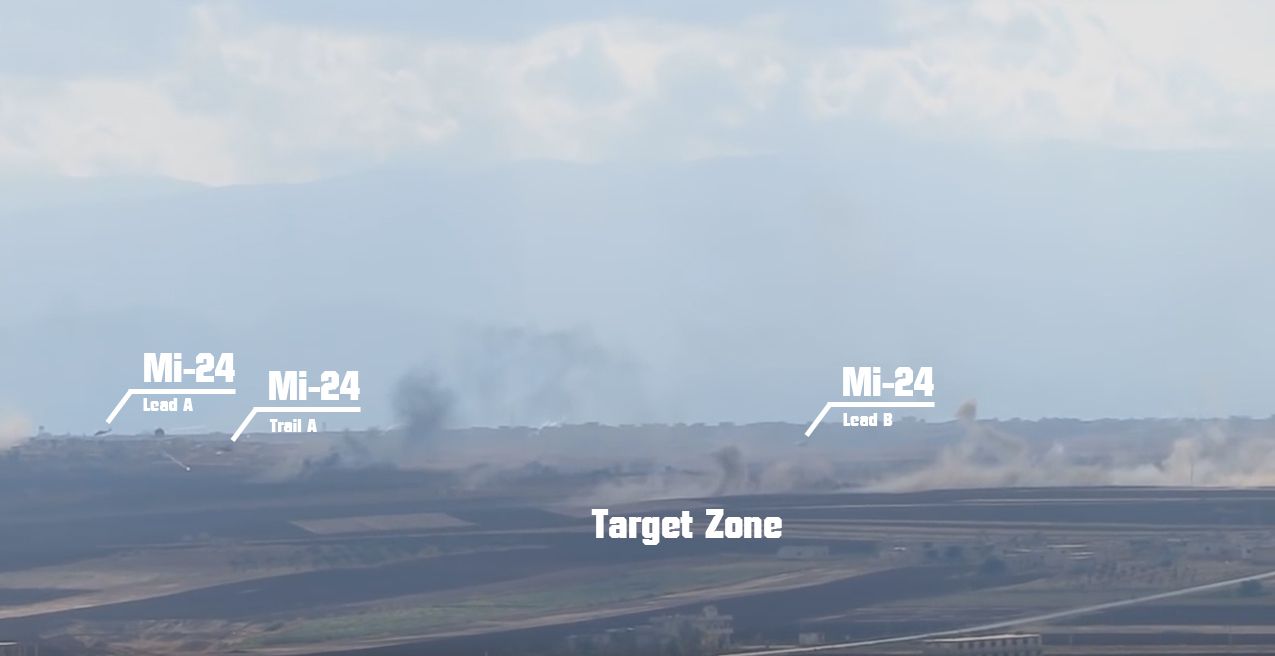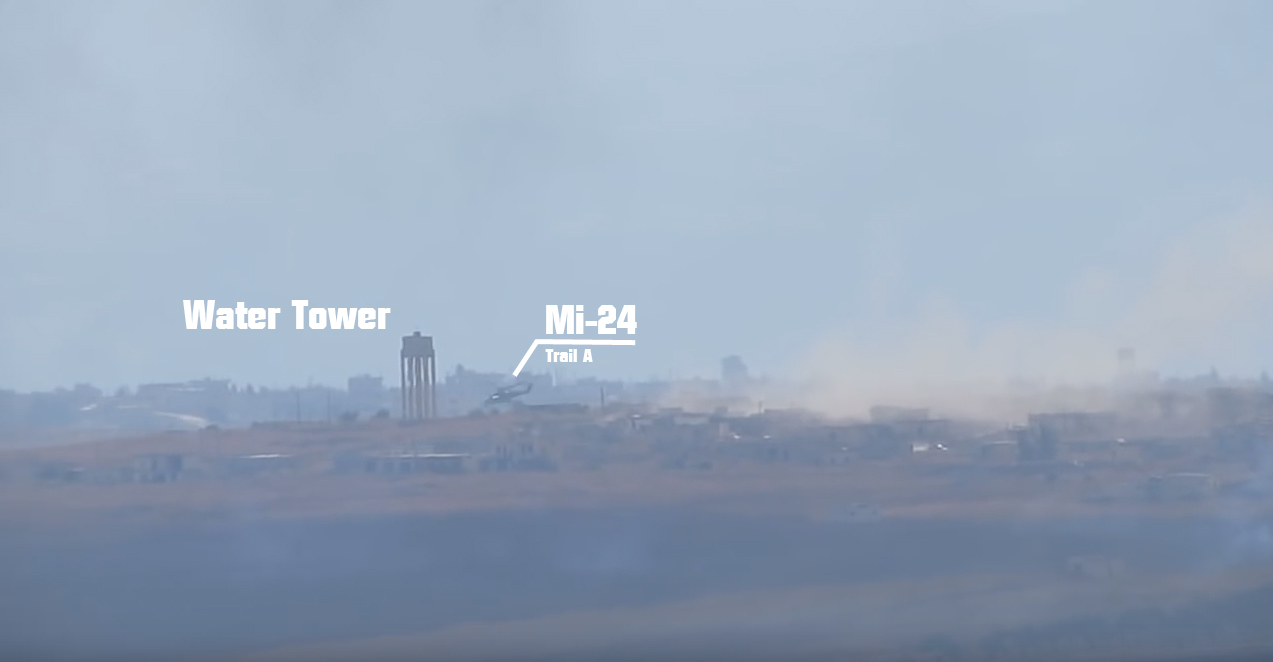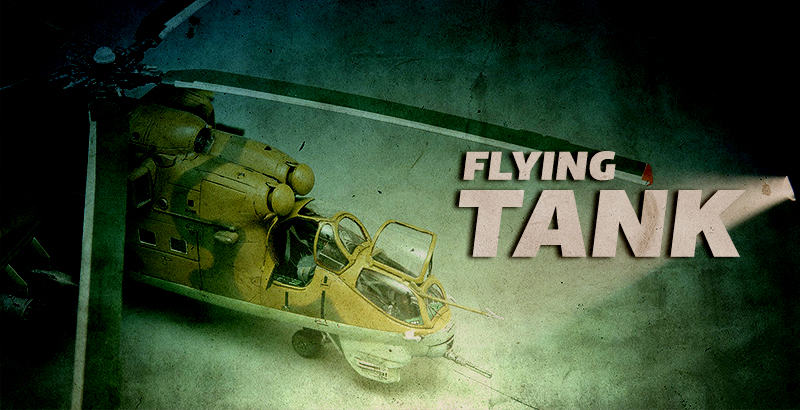
Written by Brian Betts exclusively for SouthFront
A hunched, insect-like behemoth skims mere meters off terra firma. Its bulbous intake covers and bug-eyed canopies are a Picasso portrait that evokes dread. Its proboscis injects 12.7mm anti-coagulant, punching through armor and concrete alike. The rhythmic blade slap is an ominous beat that can be heard long before the gunship appears on the horizon. The weapon pylons are mounted on downward slanting stub wings, giving the helicopter a flexing pose head-on. While the Mil Mi-24 attack helicopter has a NATO reporting name of “Hind,” it has no NATO equivalent. Over the battlefield in Syria’s Hama District, the Mi-24 continues to evolve within its own paradigm, driven by the tactics of the crews that operate it.
The Mi-24 features armor and rotors resistant to calibers up to 12.7mm (~.50 BMG), with extensive usage of lightweight titanium. Modern variants employ an articulated Yakushev-Borzov YakB-12.7 mm Gatling gun mounted to the nose. The Mi-24 often utilizes a mixture of anti-tank guided missiles, such as the 9K114 Shturm, and high quantities of ‘dumb’ rockets contained within pods. Combined with troop-carrying capacity, the heavily armored Hind’s multi-role offensive capabilities led Soviet soldiers to refer to it as letayushchiy tank, “flying tank.”
Comparisons to the Past
The Washington Post recently drew the conclusion, “In Syria, hints of Soviet helicopter tactics from Afghanistan.” The WP author primarily cites “Soviet Air Power: Tactics and Weapons used in Afghanistan,” from the Air University Review, January-February 1985 edition. Lieutenant Colonel Denny R. Nelson writes an account of Soviet helicopter tactics adapting to the introduction of CIA-sourced SA-7 man-portable air-defense systems (MANPAD) in the 1979-1989 Soviet-Afghan war. In his analysis, Lt. Colonel Nelson states:
“Current reports say the Hind now begins an attack run 7000 to 8000 meters from the target, running in at low altitude and then rising 20 to 100 meters in altitude to fire. Firing usually commences at maximum range, and mutual support is emphasized. One tactic that has endured the war has been to send one helicopter in at high altitude to draw enemy fire, while wingmen remain low, behind a ridge, ready to attack anyone who opens fire.”
Lt. Colonel Nelson goes on to say:
“The Soviets are also using helicopters in mass formations (a standard Soviet tactic). Reports have helicopters in packs of four and six, hovering, firing their rockets and machine guns, circling, hunting, and then swooping down and firing again.”
While elements of these previously executed tactics may remain, recent footage cited in the very same WP article feature new dynamics that aren’t discussed in detail. Gunships operating in the skies over Hama are flying uniquely “punitive” missions, responding to terrorist positions that have recently attacked pro-government forces.
In the following analysis, the WP cited video posted in October, 2015 is mapped using prominent landmarks to plot a route and target area. New tactics involving concealment, movement and teamwork will be highlighted.
The battle map above represents the likely route taken by two pairs of Mi-24 making a rocket attack on terrorists outside of Kafr Nabudah. Each of the numbered waypoints on the map correspond to the attack helicopter squadron’s position in the respective screen grabs below. The screen grabs themselves come from a video featuring forward observers reporting ‘four helicopters’ coming from Kernaz, towards Kafr Nabudah. In the video, the attack helicopters pass landmarks that help gauge the lead team’s position and target. Judging from the facing of the grain silos alone, we can determine that the forward observer team was located somewhere outside the village of Hobait. The attack itself lasts less than three minutes.
Approach
A cameraman and observer film two Mi-24s, Lead A and Lead B, flying between a white dome mosque in Kernaz and grain silos outside of Kafr Nabudah. The gunships fly under an altitude of 100 meters, maintaining speeds in excess of 200 km/h. While four helicopters are being reported by the observer, only the lead pair is prominently featured in the footage.
Attack
In the image above, Lead A helicopter pops up 40-60 meters over a large dirt mound approximately 1km from the terrorist position outside Kafr Nabudah. Lead A fires what appears to be an S-8 rocket barrage out of its stub wing mounted pods. The flat-faced B-8V20 rocket pod are visible in the silhouette below. Contrastingly, the older, ubiquitous UB-32 S-5 rocket launchers have conical fronts. Shturm missiles are mounted on the outermost pylons.
Fire Correction and Evasion
Out of frame to the left: The trailing pair of Mi-24s launch their unguided rockets. Pictured: Lead B pops flares to distract missile seekers as it descends from its zenith. Evidence of the punitive nature of this strike can be seen smoldering in the background. This wreck is a victim of the battle raging below; above the Russian attack helicopters serve as a quick reaction force to complex ground situations. Interestingly, Lead B seems to hold fire while taking a slightly higher approach than Lead A before popping flares. The WP article attributes this strategy to lessons learned by crews of the Soviet-Afghan war attempting to ‘distract’ the enemy with a high-flying teammate. However, in this scenario, it is far more likely that the trailing gunship in the lead pair trades a higher profile for a better perspective to correct the trailing pair’s fire. Evidence of this action can be seen in the image below.
Rocket Impact
The lead pair of attack helicopters make the turn to exit the area of operations. In parity with the lead pair’s turn, the trailing pair’s unguided rockets can be seen impacting the target zone in the image above, kicking up dirt and debris. The screen grab above also indicates that the lead pair carry a light load. With a pair of rocket pods and guided missiles (and presumably empty troop compartment) the Hind makes for a nimble gunship.
Observation
The lead pair of Mi-24s pass the trailing pair as they cycle out of the target zone. The expansive dust cloud coming from the target area is evidence of an accurate execution on the trailing pair’s rocket barrage. The trailing pair doesn’t immediately break their course after attacking, flying out to the same apex as the lead pair before turning in. This deliberate circumnavigation of the target zone leads the author to believe that the lead pair was conducting follow-up on their attack, which would certainly differ from tactics of the Soviet-Afghan war.
Exit
The gunship crews return to a white-knuckle altitude, with Trail A flying behind a prominent water tower south of Kafr Nabudah. The image above displays the impossible target the Mi-24 crews offer their opponents; the busy backdrop is filled with noise and confusion to missile seekers.
New Tactics
If we settle for the assessment that Russian attack helicopter tactics in Syria resemble tactics employed in Afghanistan, we’re really endorsing an incidental comparison. The tactics employed by Mi-24 attack helicopters in Syria have their roots in past conflicts, but are immediately influenced by the presence of BGM-71 tube-launched, optically tracked, wire-guided (TOW) missiles and the occasional MANPAD. The above example from Syria’s Hama district depicts bold strategies for pairs of attack helicopters to fire and adjust unguided rocket salvos. Using terrain to their advantage, the gunships sweep in low and fast across the countryside, offering a minimal cross section, before unleashing a barrage of 80mm rocket fire. At the same time, the tactics become more conservative outside of Kafr Nabudah, with Mi-24 crews carrying out a single coordinated strike before departing.
Sources
- https://en.wikipedia.org/wiki/Mil_Mi-24
- https://www.washingtonpost.com/news/checkpoint/wp/2015/10/08/in-syria-hints-of-soviet-helicopter-tactics-from-afghanistan/
- http://www.au.af.mil/au/afri/aspj/airchronicles/aureview/1985/jan-feb/nelson.html
- https://www.youtube.com/watch?v=XPnRwGIsdjA
- https://www.google.com/maps/place/Kafr+Nabudah,+Syria/@35.4203129,36.5051975,2240m/data=!3m1!1e3!4m5!3m4!1s0x152464308e47086b:0xd046f4c8b09397cc!8m2!3d35.4294145!4d36.4908151





